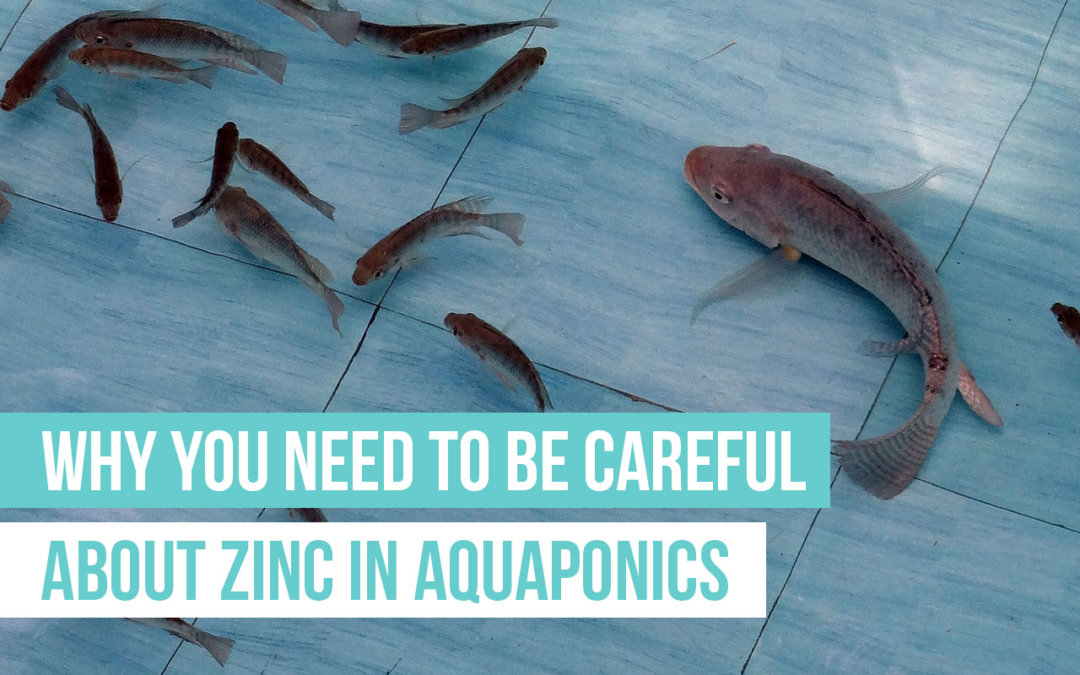Zinc is great in small quantities
Zinc (Zn) is a plant micronutrient, which means that it’s only needed in small quantities. Don’t let that fool you though—zinc, as an important component of many plant enzymes, is crucial to plant growth. Without enough zinc, plants cannot produce important enzymes, which slows many essential plant functions and results in stunted growth. Symptoms like shortened internodes and smaller leaves have been noted in plants that lack zinc.
Zinc deficiencies are rare, though, and it is far more likely that you will end up with too much rather than not enough. In aquaponic systems, zinc is most relevant in the context of toxicity.
Zinc toxicity is more common than zinc deficiency
 Zinc enters your system in many ways, the most prominent of which are fish feed and galvanized steel system components. The amount of zinc in fish feed is sufficient for your system’s needs but the amount in galvanized steel tends to send zinc levels soaring.
Zinc enters your system in many ways, the most prominent of which are fish feed and galvanized steel system components. The amount of zinc in fish feed is sufficient for your system’s needs but the amount in galvanized steel tends to send zinc levels soaring.
In addition, zinc is included as a micronutrient in most hydroponic solutions, is present in fish waste, and exists in the plating on most fasteners (washers, nuts, bolts, etc.). Thus, there is seldom a shortage of zinc in hydroponic or aquaponic systems and it is often the case that there is too much.
In aquaponics especially, zinc tends to be present in high quantities, and too much zinc can cause unnecessary problems within your system.
While plants can tolerate pretty high zinc levels, fish cannot—an abundance of zinc is actually toxic. Excess zinc inhibits calcium uptake in fish, which can be deadly.
In fact, using galvanized steel tanks is one of the major reasons that beginning aquaponic growers lose so many fish when they’re starting their systems (zinc and copper are both culprits, but more about copper later). Many growers have zinc in parts of their systems and don’t even know it.
Toxic levels of zinc will stress or even kill the introduced fish, even when all other variables seem to be just fine, leading to frustration and confusion over the source of fish stress.
Levels of zinc should be kept between 0.03 and 0.05 ppm as most fish will become stressed at 0.1 to 1 ppm, and will start dying off at 4-8 ppm.
Control zinc by using the right equipment
There are a few ways to reduce the amount of zinc in your system. The first is to avoid using zinc plated and galvanized steel equipment—there are many stainless steel and plastic alternatives.
 If a galvanized stock tank is the only option available, the second way to limit zinc in your system is to coat the galvanized steel components with a thick industrial epoxy. We have used galvanized steel tanks coated with epoxy paint in the past with great success.
If a galvanized stock tank is the only option available, the second way to limit zinc in your system is to coat the galvanized steel components with a thick industrial epoxy. We have used galvanized steel tanks coated with epoxy paint in the past with great success.
Coat all interior tank surfaces in order to separate the galvanized surface from your system solution and protect your fish from the zinc.
Galvanized or zinc-plated surfaces in biological systems can eventually become covered with bio-film, algae, and other organic matter. Over time, this forms a natural barrier between the surface of the tank and the solution and can allow fish to live in galvanized tanks. However, it takes time for these films to develop and if you want to start your system quickly, this isn’t an option.
There are some additional options for avoiding zinc toxicity to keep fish alive, check them out here.
Zinc can be very helpful to your plants, and won’t hurt your fish at low levels. Carefully choose your system components and be wise about how you use them.
Learn about other nutrients
For more information on zinc and other nutrients in aquaponic and hydroponic systems check out our YouTube Channel, and for more free resources join our email community.
Read the articles on aquaponic nutrients and be sure to take the Foundations of Aquaponics course!



A very helpful site… indeed am having problem with my Aquaponics especially because of lack of nutrition it means as I have read it in your article.i LL try to maximize the number of fishes on the container.
I have an established water garden in a galvanized tank.im not sure how but I have seen tiny fish in it ( possibly introduced with plants?) Could I safely assume there is enough bio material build up to try introducing more fish for an aquaponics system? It is not coated but at least 8 years old